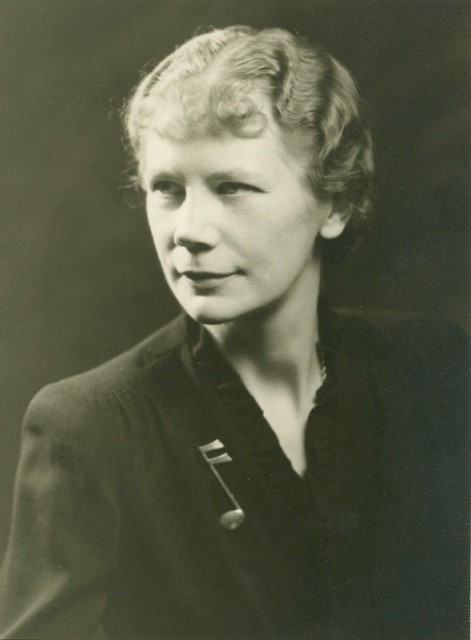Queer Places:
Juilliard School, 60 Lincoln Center Plaza, New York, NY 10023
New York University, 70 Washington Square S, New York, NY 10012
Columbia University (Ivy League), 116th St and Broadway, New York, NY 10027
Hunter College, 695 Park Ave, New York, NY 10065
MacDowell Colony, 100 High St, Peterborough, NH 03458
Yaddo, 312 Union Ave, Saratoga Springs, NY 12866
Gate of Heaven Cemetery
Hawthorne, Westchester County, New York, USA
 Louise Juliette Talma (October 31, 1906 – August 13, 1996) was an American composer, academic, and pianist. After studies in New York and in France, piano with Isidor Philipp and composition with
Nadia Boulanger, she focused on composition from 1935. She taught at the American Conservatory in Fontainebleau, and at Hunter College. Her opera The Alcestiad was the first full-scale opera by an American woman staged in Europe. She was the first women in the National Institute of Arts and Letters and being awarded the Sibelius Medal for Composition.
Talma's copious correspondence reveals several passionate affairs with women, including one in late life with
Ethelston (Eth) Chapman, who had been a fellow student in Fontainebleau with Talma. She never married.
Louise Juliette Talma (October 31, 1906 – August 13, 1996) was an American composer, academic, and pianist. After studies in New York and in France, piano with Isidor Philipp and composition with
Nadia Boulanger, she focused on composition from 1935. She taught at the American Conservatory in Fontainebleau, and at Hunter College. Her opera The Alcestiad was the first full-scale opera by an American woman staged in Europe. She was the first women in the National Institute of Arts and Letters and being awarded the Sibelius Medal for Composition.
Talma's copious correspondence reveals several passionate affairs with women, including one in late life with
Ethelston (Eth) Chapman, who had been a fellow student in Fontainebleau with Talma. She never married.
Born in Arcachon in France to an American mother, Alma Cecile Garrigues, a professional soprano who took the name Cecile Talma around 1900, and a father whose identity remains unknown. Mother and daughter returned to the United States in 1914, settling in New York City. Talma grew up surrounded by music but was also an excellent science student and considered becoming a chemist before deciding on a career as a musician. After graduating from Wadleigh High School,
she studied chemistry at Columbia University, and simultaneously piano and composition at the Institute of Musical Arts (which became the Juilliard School) from 1922 to 1930.[1] She received her bachelor of music degree from New York University and masters of arts degree from Columbia University.[1] She studied piano with Isidor Philipp at the American Conservatory in Fontainebleau, France, every summer from 1926 to 1935. From 1928, she studied annually composition with Nadia Boulanger, deciding in 1935 to focus on composition. She continued the studies with Boulanger until 1939.[1] Talma taught at Hunter College of the City University of New York from the late 1920s.[1]

Under Boulanger's guidance, Talma gave up her piano studies in order to focus on composition, converted from agnosticism to Roman Catholicism in 1934 with Boulanger as her godmother, and adopted a lifestyle similar to Boulanger's in its devotion to music. While many of her early works express desire for an unattainable beloved (likely Boulanger), she also composed more than 20 religious works after her conversion, setting a number of sacred texts and spiritual writings. Talma's first pieces show an interest in neo-classical approaches and techniques and appear to be highly autobiographical, establishing compositional patterns that would continue throughout her career. Speaking of her creative life, Talma identified three periods: her early works, which were composed during her “neo-classical period,” 1925–1951; her “serial period,” 1952–1967; and her “non-serial atonal period,” 1967–1996. However, after adopting serial methods in 1952, the majority of her works even in this last period owe something to serial approaches, especially in terms of melody creation.
Talma's Piano Sonata No. 1 (1943), Toccata for Orchestra (1944) and Alleluia in the Form of Toccata for piano (1945) were highly praised by critics and helped establish Talma as an important American composer at the beginning of her career.
Based in part on the success of these works, she was the second woman (after Ruth Crawford Seeger in 1930) to receive a Guggenheim Fellowship in music composition and the first woman awarded back-to-back Guggenheims in 1946 and 1947.
In the 1940s Talma also began spending each summer at the MacDowell Colony in Peterborough, New Hampshire, where most of her mature works were composed.
Talma was a full-time member of the music faculty at Hunter College in New York from 1928 until 1979, during which time she helped author two harmony textbooks for her students.
In 1952, Talma heard Irving Fine's serial but tonally-centered string quartet and immediately began working with serial approaches and techniques in her works. Although she stated that her serial period primarily extended from 1952 to 1967, the majority of her works up until her death engaged with some form of serial practice. Her setting of
e. e. cummings's “Let’s Touch the Sky” was her first completed serial work; her String Quartet (1954), Piano Sonata No. 2 (1955), and La Corona (1955), a setting of John Donne's Holy Sonnets all use clearly audible serial elements. As she developed her own compositional voice using serial elements, Talma created rows that allowed for tonal centering as well as more traditional, stricter use of pitch class sets.
Talma began working on a grand opera with writer
Thornton Wilder in 1954 after the two had met while working at the MacDowell Colony. They considered several scenarios before deciding to base the opera on Wilder's existing stage play about the Greek figure Alcestis. Composed while Talma was in residence at the American Academy in Rome and at the MacDowell Colony, The Alcestiad was completed in 1958. Although several American opera houses, including the Lyric Opera in Chicago, the Met, and the San Francisco Opera, expressed interest in the work, all of them deemed it too difficult for American performers and audiences. Wilder had previously enjoyed considerable success in Germany, and Die Alkestiade was premiered by the Oper Frankfurt in 1962. It was the first time full-scale opera by an American woman was performed at a major European theatre. However, perhaps due to the enormous resources the work requires, and despite the fact that it was critically and publicly well-received, it remains relatively unknown.
Nonetheless, The Alcestiad secured Talma a place in the ranks of ground-breaking American and female composers; in 1963 she was the first female composer to win the Harriet Cohen International Music Award; and in 1974 was the first woman elected to the American Academy and Institute of Arts and Letters.
Talma's extensive body of works include vocal and choral pieces and works for solo piano, chamber ensembles, and orchestra, as well as a chamber opera, and settings of texts by Auden, Browning, Dickinson, Donne, Hopkins, Keats, Marlowe, Shakespeare, Stevens, Wyatt, and others. Talma dedicated several works to John F. Kennedy after his assassination, including Dialogues for piano and orchestra (1964) and A Time to Remember (1967), an oratorio that sets Kennedy's own words. The Tolling Bell, Talma's setting of texts by Shakespeare, Marlowe, and Donne for baritone and orchestra, was completed in 1969 and nominated for the Pulitzer Prize in music. Talma wrote her own libretto for her 1976 chamber opera, Have You Heard? Do You Know?, a work about the Cold War and the desire for utopias; and continued to compose prolifically into her eighties.
She died in Saratoga Springs, New York while working on an elegiac piece, The Lengthening Shadows, while in residence at the Yaddo colony.
A full-length study of Talma's music by musicologist Kendra Preston Leonard, Louise Talma: A Life in Composition, was published in 2014.
My published books:


BACK TO HOME PAGE

 Louise Juliette Talma (October 31, 1906 – August 13, 1996) was an American composer, academic, and pianist. After studies in New York and in France, piano with Isidor Philipp and composition with
Nadia Boulanger, she focused on composition from 1935. She taught at the American Conservatory in Fontainebleau, and at Hunter College. Her opera The Alcestiad was the first full-scale opera by an American woman staged in Europe. She was the first women in the National Institute of Arts and Letters and being awarded the Sibelius Medal for Composition.
Talma's copious correspondence reveals several passionate affairs with women, including one in late life with
Ethelston (Eth) Chapman, who had been a fellow student in Fontainebleau with Talma. She never married.
Louise Juliette Talma (October 31, 1906 – August 13, 1996) was an American composer, academic, and pianist. After studies in New York and in France, piano with Isidor Philipp and composition with
Nadia Boulanger, she focused on composition from 1935. She taught at the American Conservatory in Fontainebleau, and at Hunter College. Her opera The Alcestiad was the first full-scale opera by an American woman staged in Europe. She was the first women in the National Institute of Arts and Letters and being awarded the Sibelius Medal for Composition.
Talma's copious correspondence reveals several passionate affairs with women, including one in late life with
Ethelston (Eth) Chapman, who had been a fellow student in Fontainebleau with Talma. She never married. 

